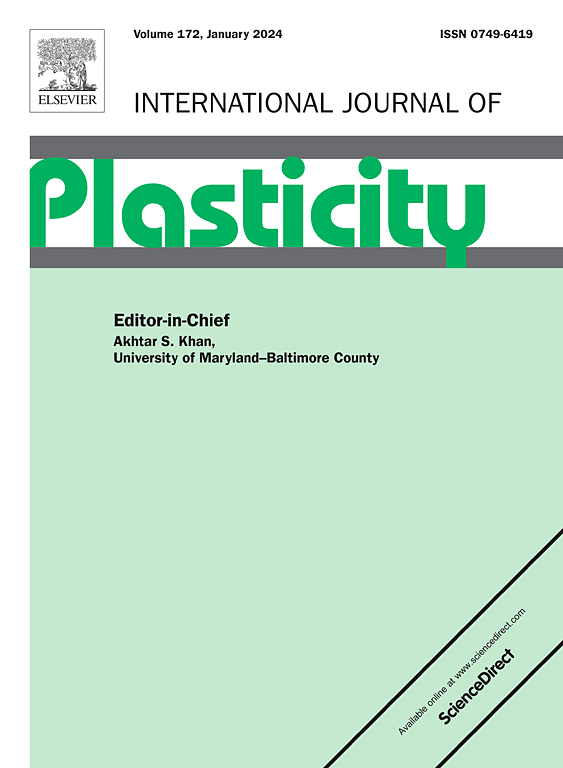Enhancing fatigue crack propagation resistance of heterostructured Al composites and multistage crack mechanisms
IF 9.4
1区 材料科学
Q1 ENGINEERING, MECHANICAL
引用次数: 0
Abstract
High tensile strength and low fatigue crack propagation (FCP) rate are hard to achieve simultaneously in aluminium (Al) based materials, which has been a long-lasting topic. It is because the traditional strengthening mechanisms may lead to the increase in FCP rate. In this work, we developed dual-level heterostructures by incorporating the in-situ synthesized TiB2 particles into Al matrix, to create particle-lean zones (PLZs) and particle-rich zones (PRZs) by extrusion. Fine grains were introduced by particle-associated local recrystallization in PRZs. By means of particle and grain size distribution, a heterostructured Al composite featuring with the coarse grains in PLZs and fine grains in PRZs was fabricated. It was found that simultaneous enhancement of both the strength and FCP resistance of Al composite was achieved through the development of heterostructures. During FCP, the PRZs can retard the growth of slip bands and increase crack deflection frequency while the PLZs increase the crack deflection distance and plastic deformation capability at crack tip. The fracture behavior of composite during FCP depended on grain characteristics, particles and stress intensity range. The detailed cracking behavior for typical <100>Al and <111>Al grains in different FCP stages was identified. The associated models were developed for different FCP behaviors. Particularly, the quantitative relationship between Pairs parameters and microstructure features was established, which was critical to understand fatigue properties of Al composite reinforced by small particles. These findings can provide a strategy to design metal materials with an excellent combination of both static and dynamic mechanical properties.
增强异质结构铝复合材料的抗疲劳裂纹扩展能力和多级裂纹机制
在铝(Al)基材料中很难同时实现高抗拉强度和低疲劳裂纹扩展(FCP)率,这一直是一个持久的话题。这是因为传统的强化机制可能会导致 FCP 率的增加。在这项工作中,我们将原位合成的 TiB2 粒子加入铝基体中,通过挤压形成粒子稀疏区 (PLZ) 和粒子富集区 (PRZ),从而开发出双层异质结构。在 PRZ 中,通过与颗粒相关的局部再结晶引入了细晶粒。通过颗粒和晶粒尺寸分布,制备出了一种异质结构的铝复合材料,其特点是 PLZ 中为粗颗粒,PRZ 中为细颗粒。研究发现,通过发展异质结构,铝复合材料的强度和抗 FCP 能力同时得到了提高。在 FCP 过程中,PRZs 可延缓滑移带的生长并增加裂纹偏转频率,而 PLZs 则可增加裂纹偏转距离和裂纹尖端的塑性变形能力。复合材料在 FCP 期间的断裂行为取决于晶粒特征、颗粒和应力强度范围。确定了典型的 <100>Al 和 <111>Al 晶粒在不同 FCP 阶段的详细开裂行为。针对不同的 FCP 行为建立了相关模型。特别是,建立了配对参数与微结构特征之间的定量关系,这对于理解小颗粒增强的铝复合材料的疲劳特性至关重要。这些发现可为设计兼具静态和动态机械性能的金属材料提供策略。
本文章由计算机程序翻译,如有差异,请以英文原文为准。
求助全文
约1分钟内获得全文
求助全文
来源期刊

International Journal of Plasticity
工程技术-材料科学:综合
CiteScore
15.30
自引率
26.50%
发文量
256
审稿时长
46 days
期刊介绍:
International Journal of Plasticity aims to present original research encompassing all facets of plastic deformation, damage, and fracture behavior in both isotropic and anisotropic solids. This includes exploring the thermodynamics of plasticity and fracture, continuum theory, and macroscopic as well as microscopic phenomena.
Topics of interest span the plastic behavior of single crystals and polycrystalline metals, ceramics, rocks, soils, composites, nanocrystalline and microelectronics materials, shape memory alloys, ferroelectric ceramics, thin films, and polymers. Additionally, the journal covers plasticity aspects of failure and fracture mechanics. Contributions involving significant experimental, numerical, or theoretical advancements that enhance the understanding of the plastic behavior of solids are particularly valued. Papers addressing the modeling of finite nonlinear elastic deformation, bearing similarities to the modeling of plastic deformation, are also welcomed.
 求助内容:
求助内容: 应助结果提醒方式:
应助结果提醒方式:


